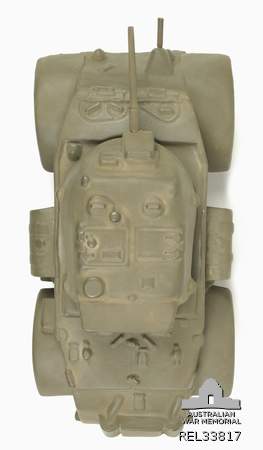| Places | |
|---|---|
| Accession Number | REL33817 |
| Collection type | Technology |
| Object type | Model |
| Physical description | Ceramic, Wire, Wood |
| Maker |
Hammond, Stanley James |
| Place made | Australia |
| Date made | c 1944 |
| Conflict |
Period 1950-1959 Period 1960-1969 Second World War, 1939-1945 British Commonwealth Occupation Force, 1946-1952 (Japan) |
Ceramic recognition model : M6 Staghound Armoured Car





Hollowcast ceramic model of an M6 Staghound Armoured Car in approximately 1:24 scale with separate hollowcast turret which is loosely wired to the body through a small hole, access to which is gained through a larger hole in the base of the model. This allows the turret to swivel. The base is impressed 'M6 STAGHOUND / D^D / ALLIED', and has been ink-stamped with a crown acceptance stamp. Both the turret gun and glacis guns are made from wood. The entire model has been painted olive drab, with evidence of overspray to the plain white internal ceramic.
Australian produced hollowcast ceramic identification model of the American-manufactured T17E1 (M6) Staghound Armoured Car, as used by 1 Australian Armoured Car Squadron during its deployment to Japan as part of the British Commonwealth Occupation Forces (BCOF). The master was sculpted by Melbourne artist Stanley James Hammond in dental plaster, from which moulds were made for mass-production at an as-yet unidentified Melbourne pottery firm. A Japanese Ha-Go tank was the first vehicle produced.
The model was produced by the Australian Department of Defence, as evidenced by the D^D stamp impressed into the base, a black ink rubber stamped acceptance stamp in the shape of a crown, also on the base, and the fact that the turret is modelled to include the addition of a rear storage box - a unique Australian addition. The description 'Allied' on the base of the model indicates that this is part of a range of similar ceramic identification models which included allied and Japanese tanks. Correspondence (see AWM61: 552/3/395) dated 26 January 1944 from Chief of General Staff to Headquarters units and tank schools refers to the manufacture of 'pottery model tanks' and delays in manufacture.
The full sized, 12 tonne Staghound was manufactured by General Motors' Chevrolet Motor Division, had a crew of five, was driven by a pair of GM straight six petrol engines allowing a top speed in the region of 88 kph; and was armed with an M6 37 mm gun in the turret, a fixed .30 cal machine gun mounted on the glacis plate, and a further pair of.30 cal machine guns flexible mounted to the top of the turret. A total of 367 M6 Staghounds were ordered from the United States; 279 were delivered, with the first 18 being delivered late in 1943 and the balance arriving between May and August 1944. The Staghound was not used operationally by Australia during the Second World War, but nonetheless appears in a November 1944 equipment schedule for Australian armoured car regiments. Australia's commitment to the BCOF deployment in Japan included 1 Armoured Car Squadron, raised with volunteers from various units of 4 Australian Armoured Brigade. Eighteen Staghounds and eight Canadian Lynx Scout Cars were issued to 1 Australian Armoured Car Squadron during February 1946, which trained on their new mounts during February and March at Puckapunyal. The unit was deployed to Japan in April 1946, but the state of Japanese roads and the weight of the Staghound meant they could only be deployed in an extremely limited area. The unit war diary for the July period states, 'reconnaissance disclosed an even more dismal prospect for the use of Staghounds than had at first been realised. ... the weight of the vehicles proved too much for a built-up section of the road at Koi ... and when the road gave way on one side, one of our armoured cars turned over into the muddy paddy fields ... In effect, the Staghound going is restricted to less than 30 miles of coastal road between Hiroshima and a point two miles east of Nigata.' This ultimately led to a reduction in the use of Staghounds from 18 to one troop of four, with the shortfall made up in the lighter Lynx Scout Car. The Unit returned to Australia in December 1948 and was subsequently renamed 1 Armoured Regiment, becoming the first armoured unit in the Australian Regular Army. Army Reserve (CMF) armoured units began using the Staghound as a training vehicle from 1956; disposal of the Staghound had already commenced by this time and Australian holdings had dropped from 279 to 115 by August 1959. By 1964, the Staghound was being replaced by other vehicles, finally going out of service in the early 1970s.